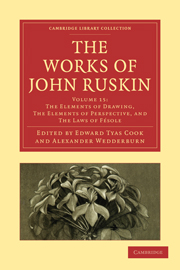Book contents
- Frontmatter
- Contents
- LIST OF ILLUSTRATIONS
- INTRODUCTION TO THIS VOLUME
- “THE ELEMENTS OF DRAWING” (1857)
- “THE ELEMENTS OF PERSPECTIVE” (1859)
- THE LAWS OF FÉSOLE” (1877—1878)
- APPENDIX
- I DRAWING LESSONS BY LETTER (1855)
- II A REVIEW OF “THE ELEMENTS OF DRAWING”: RUSKIN AND WILLIAM BELL SCOTT (1875)
- III PASSAGES FROM THE MS. OF THE INTENDED CONTINUATION OF “THE LAWS OF FÉSOLE”
- Plate section
III - PASSAGES FROM THE MS. OF THE INTENDED CONTINUATION OF “THE LAWS OF FÉSOLE”
Published online by Cambridge University Press: 05 March 2012
- Frontmatter
- Contents
- LIST OF ILLUSTRATIONS
- INTRODUCTION TO THIS VOLUME
- “THE ELEMENTS OF DRAWING” (1857)
- “THE ELEMENTS OF PERSPECTIVE” (1859)
- THE LAWS OF FÉSOLE” (1877—1878)
- APPENDIX
- I DRAWING LESSONS BY LETTER (1855)
- II A REVIEW OF “THE ELEMENTS OF DRAWING”: RUSKIN AND WILLIAM BELL SCOTT (1875)
- III PASSAGES FROM THE MS. OF THE INTENDED CONTINUATION OF “THE LAWS OF FÉSOLE”
- Plate section
Summary
[Ruskin intended to complete the Laws of Fésole by a second volume, “treating mostly of colour” (above, p. 346). This second volume was never published or put into shape, but among the author's MSS., collected with other matter in a bound volume now at Brantwood, are many sheets intended for it. Some contain the beginnings of chapters; others, notes, memoranda, and diagrams of intended exercises. Among this material are several sheets of diagrams, etc., showing that Ruskin at one time intended to carry further the examination “Of Elementary Organic Structure” (ch. vi.), and to enter upon an elaborate discussion of the mathematical laws of proportion, and of spirals in art. This material, however, is very fragmentary and incomplete. On other sheets, dealing with colour, there are a few passages which are intelligible in themselves, and of sufficient interest to be worth printing.]
STANDARDS OF COLOUR
Thus far I have been speaking only of hues of colour, absolute; I have next to state the laws regarding their texture and quality.
There are essentially three kinds of colours in natural objects: first, those of transparent substances, as of red wine; secondly, those of entirely opaque substances, with lustreless surface, as the colour of the bloom on a plum; and lastly, the colour of opaque substances burnished, polished, or wet, as of fine agates, marbles, and burnished metals.
- Type
- Chapter
- Information
- The Works of John Ruskin , pp. 495 - 501Publisher: Cambridge University PressPrint publication year: 2010First published in: 1904

